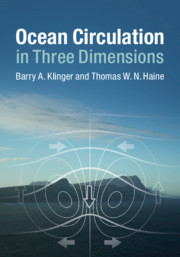Description
Ocean Circulation in Three Dimensions
Authors: Klinger Barry A., Haine Thomas W. N.
An innovative survey of large-scale ocean circulation that links observations, conceptual models, numerical models, and theories.
Language: English
Subject for Ocean Circulation in Three Dimensions:
Approximative price 64.99 €
In Print (Delivery period: 14 days).
Add to cart
Publication date: 03-2019
484 p. · 19.2x25.3 cm · Hardback
484 p. · 19.2x25.3 cm · Hardback
Description
/li>Contents
/li>Biography
/li>
Notable advances of the last quarter-century have deepened our appreciation of the three-dimensional nature of the ocean's large-scale circulation. This circulation has important implications for ocean chemistry and biology, atmospheric science, and climate. Ocean Circulation in Three Dimensions surveys both observations and theories of the time-mean circulation, enabling readers to see the relevance and limitations of leading theories, as well as the patterns linking the behavior of different oceans. The book covers ?classical? topics of horizontal circulation, and expands them to include shallow wind-driven overturning, the deep global ?conveyer belt?, high latitudes, the role of eddies, and the ocean's role in heat transport. Solutions to exercises are available online for instructor use. This textbook is ideal for students of physical oceanography, chemical oceanography and climate. It is also suitable for readers from related fields as it includes a summary of introductory topics.
1. Physical oceanography: methods and dynamical framework; 2. Rotating and shallow water flow; 3. Two-dimensional horizontal circulation; 4. Surface and mixed layer properties; 5. Depth-dependent gyre circulation; 6. Equatorial circulation, shallow overturning, and up-welling; 7. Eddies and small scale mixing; 8. Deep meridional overturning; 9. The Southern Ocean nexus; 10. Arctic circulation; 11. Heat flux, freshwater flux, and climate; Appendix A. Data sources; Appendix B. Vector calculus and spherical coordinates; Appendix C. Tables of notation and useful values; References; Index.
Barry A. Klinger is Associate Professor in the Department of Atmospheric, Oceanic and Earth Sciences at George Mason University, Virginia. His primary research interests are large-scale ocean circulation and its effects on climate, which he investigates with numerical models and theory. Since the early 2000s, he has been affiliated with the Climate Dynamics Doctoral program at George Mason University.
Thomas W. N. Haine is Morton K. Blaustein Chair and Professor of Earth and Planetary Sciences in the Department of Earth and Planetary Sciences at The Johns Hopkins University. He studies and teaches ocean circulation and the ocean's role in climate and has participated in many oceanographic expeditions. He has pioneered understanding of how the ocean stores and transports trace substances, and is currently investigating how the Arctic and sub-Arctic oceans are responding to, and influencing, climate change.
Thomas W. N. Haine is Morton K. Blaustein Chair and Professor of Earth and Planetary Sciences in the Department of Earth and Planetary Sciences at The Johns Hopkins University. He studies and teaches ocean circulation and the ocean's role in climate and has participated in many oceanographic expeditions. He has pioneered understanding of how the ocean stores and transports trace substances, and is currently investigating how the Arctic and sub-Arctic oceans are responding to, and influencing, climate change.
© 2024 LAVOISIER S.A.S.




